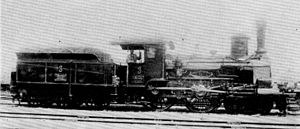MÁV I
| MÁV I / MÁV series 259 | |
|---|---|
|
MÁV I 3
|
|
| Numbering: | MÁV 159–164 MÁV I 1–6 MÁV 259,001–006 |
| Number: | 6th |
| Manufacturer: | Web |
| Year of construction (s): | 1874 |
| Axis formula : | 2'B n2 |
| Gauge : | 1435 mm ( standard gauge ) |
| Length: | 8,076 mm |
| Height: | 4,320 mm |
| Width: | 2,975 mm |
| Fixed wheelbase: | 2,100 mm |
| Total wheelbase: | 4,870 mm |
| Empty mass: | 34.1 t |
| Service mass: | 38.05 t |
| Friction mass: | 21.4 t |
| Driving wheel diameter: | 1,900 mm |
| Impeller diameter: | 950 mm |
| Number of cylinders: | 2 |
| Cylinder diameter: | 400 mm |
| Piston stroke: | 632 mm |
| Boiler overpressure: | 10 atü |
| Number of heating pipes: | 170 |
| Heating pipe length: | 3,160 m |
| Grate area: | 2.0 m² |
| Radiant heating surface: | 8.1 m² |
| Tubular heating surface: | 87.4 m² |
| Evaporation heating surface: | 95.5 m² (in contact with water) |
The MÁV I was the first outspoken fast - Tender Locomotive series of Hungarian State Railways MÁV for the express train service on main routes:
The six machines were supplied by the StEG locomotive factory in 1874. They belonged to the Rittinger type typical of Austria-Hungary at that time. The rear coupling axle was relocated behind the standing boiler. The two running axles were designed as a bogie.
The MÁV gave the machines the numbers 159–164 in their first designation scheme. In the second scheme from 1891 they were classified as Category I with the numbers 1-6. In the third scheme valid from 1911 they were given the designation 259,001–006.
In operation, the vehicles proved to be too weak due to insufficient steam generation.
literature
- Locomotive types of the kk landesbef. Machine factory in Vienna of the priv. Austro-Hungarian State Railway Company . M. Engel & Sohn, kk Hof-Buchdruckerei und Hof-Lithographie, Vienna 1888.
- Mihály Kubinszky (ed.): Hungarian locomotives and railcars . Akadémiai Kiadó, Budapest 1975, ISBN 963-05-0125-2 .
